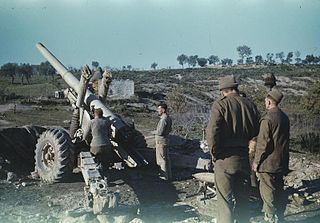
The Lockheed AC-130 gunship is a heavily armed, long-endurance, ground-attack variant of the C-130 Hercules transport, fixed-wing aircraft. It carries a wide array of ground-attack weapons that are integrated with sensors, navigation, and fire-control systems. Unlike other modern military fixed-wing aircraft, the AC-130 relies on visual targeting. Since its large profile and low operating altitudes around 7,000 feet make it an easy target, its close air support missions are usually flown at night.

A field gun is a field artillery piece. Originally the term referred to smaller guns that could accompany a field army on the march, that when in combat could be moved about the battlefield in response to changing circumstances, as opposed to guns installed in a fort, or to siege cannons and mortars which are too large to be moved quickly, and would be used only in a prolonged siege.

A gunship is a military aircraft armed with heavy aircraft guns, primarily intended for attacking ground targets either as airstrike or as close air support.

The Vietnam War involved the People's Army of Vietnam (PAVN) or North Vietnamese Army (NVA), National Liberation Front for South Vietnam (NLF) or Viet Cong (VC), and the armed forces of the People's Liberation Army (PLA), Army of the Republic of Vietnam (ARVN), United States Armed Forces, Republic of Korea Armed Forces, Armed Forces of the Philippines, Royal Thai Armed Forces, Australian Defence Force, and New Zealand Defence Force, with a variety of irregular troops.

The GC-45 is a 155 mm howitzer designed by Gerald Bull's Space Research Corporation (SRC) in the 1970s. Versions were produced by a number of companies during the 1980s, notably in Austria and South Africa.

The LG1 is a modern 105 mm towed howitzer designed and produced by GIAT Industries of France.

The BL 5.5-inch gun was a British artillery gun introduced during the Second World War to equip medium batteries.

The M119 howitzer is a lightweight 105 mm howitzer, used by the United States Army. It is the American licensed version of the British L119 light gun. The M119 is typically towed by the M1097 or M1152 High Mobility Multi-Purpose Wheeled Vehicle (HMMWV), and can be easily airlifted by helicopter, or airdropped by parachute.

The L118 light gun is a 105 mm towed howitzer. It was originally designed and produced in the United Kingdom for the British Army in the 1970s. It has since been widely exported. The L119 and the United States Army's M119 are variants that use a different type of ammunition.

The M101A1 howitzer is an artillery piece developed and used by the United States. It was the standard U.S. light field howitzer in World War II and saw action in both the European and Pacific theaters and during the Korean War. Entering production in 1941, it quickly gained a reputation for accuracy and a powerful punch. The M101A1 fires 105 mm high explosive (HE) semi-fixed ammunition and has a range of 12,330 yards (11,270 m), making it suitable for supporting infantry.

The 105 mm Howitzer M3 was a U.S. light howitzer designed for use by airborne troops. The gun utilized the barrel of the 105 mm Howitzer M2, shortened and fitted to a slightly modified split trail carriage of the 75 mm pack howitzer.

The 240 mm howitzer M1, popularly nicknamed the "Black Dragon", was a towed howitzer used by the United States Army. The 240 mm M1 was designed to replace the World War I era 240 mm howitzer M1918, which was based on a 1911 French design and was outdated by World War II.

The Cambodian Civil War was a military conflict that pitted the guerrilla forces of the Maoist-oriented Communist Party of Kampuchea and the armed and security forces of the Nonaligned Kingdom of Cambodia from 1967 to 1970, then between the joint Monarchist, Maoist and Marxist-Leninist National United Front of Kampuchea alliance and the pro-western Khmer Republic from 1970 to 1975. Main combatants comprised:
Riverine artillery refers to artillery employment on a river, generally on floating barges. Transport of field artillery is difficult through the moist ground and riparian forest adjacent to low-gradient rivers. Traditional naval artillery is mounted on deep-draft vessels unsuited for operations in shallow rivers.

Counter-insurgency aircraft or COIN aircraft are a specialized variety of military light attack aircraft, designed for counter-insurgency operations, armed reconnaissance, air escort of ground forces, and ground support against "low-intensity engagements"; usually irregular groups of insurgents armed with aircraft artillery and/or portable rockets.
105 mm is a common NATO-standard artillery and tank gun calibre. The rifled tank round is defined by STANAG 4458. The artillery round is defined by AOP-29 part 3 with reference to STANAG 4425.
Operation Kien Giang 9-1 was a joint U.S. and Army of the Republic of Vietnam (ARVN) operation in Dinh Tuong Province from 16–19 November 1967.

The KH178 is a South Korean 105 mm 38 caliber towed howitzer. It was designed and developed by the Agency for Defense Development (ADD) for the Republic of Korea Armed Forces and manufactured by Hyundai WIA.



















